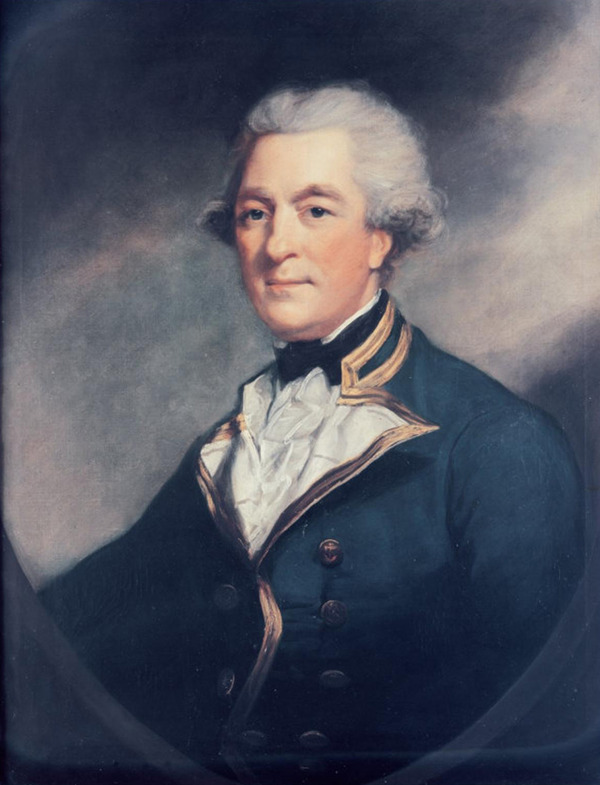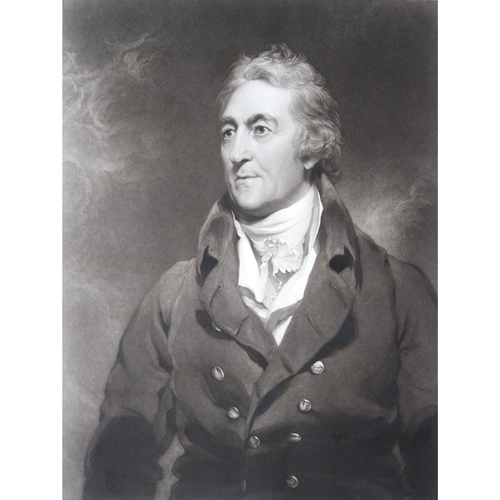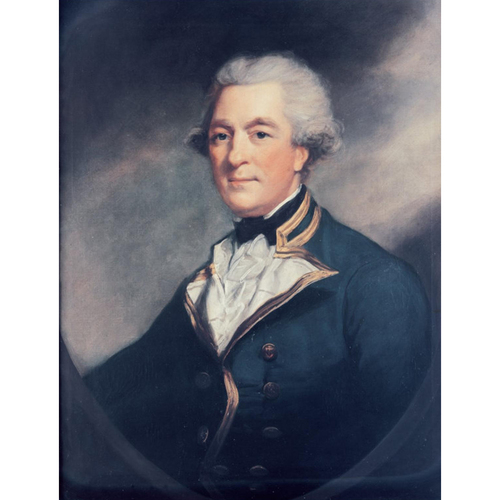
Source: Courtesy of Wikimedia Commons
HAMOND, Sir ANDREW SNAPE, naval officer and colonial administrator; b. 17 Dec. 1738 in Blackheath (London), England, only son of Robert Hamond and Susannah Snape; m. first April 1763 Cecilia Sutherland; m. secondly 7 March 1779 Anne Graeme, and they had two children; d. 12 Sept. 1828 in Terrington Clement, England.
Andrew Snape Hamond entered the Royal Navy in 1753 and served during the Seven Years’ War. Promoted post captain in 1770, he was present at most of the important naval actions of the American Revolutionary War up to 1780; in 1779 he was told “that scarce a dispatch had arrived from the active part of the War, that did not make mention of some creditable exploit in which [he] had been engaged against the Enemy.” While in England in 1780 he was offered and accepted the posts of resident commissioner of the naval dockyard at Halifax and lieutenant governor of Nova Scotia, replacing Sir Richard Hughes*. Two years later he would be appointed to the naval command in the province as well.
Hamond and his family arrived in Halifax during the night of 29–30 July 1781; he was sworn into office on the 31st. That the highest priority of his administration would be defence was demonstrated on 29 August, when two American privateers raided Annapolis Royal [see John Ritchie*]. A more serious assault took place the next year by a squadron of privateers on Lunenburg [see John Creighton*]. When news of the second attack reached Halifax, Hamond sent a force to pursue the raiders. As commander-in-chief, he inspected the Halifax County militia in the autumn of 1781 and the outlying county militias the following spring. Apart from defensive measures, Hamond was most concerned to guarantee the supply of masts from the Saint John valley (N.B.) [see William Davidson*]. In this effort he was successful: the Indians of the region remained at peace.
The naval hospital at Halifax was in a bad state when Hamond arrived, and he soon “found it absolutely necessary to prepare for building an Hospital in the Spring.” Tenders were called for in December 1781, and the new facility, which cost almost £8,000 and could accommodate 200 patients, was ready by the end of 1782. Its first physician was the Rhode Island loyalist John Halliburton.
Hamond’s tenure as lieutenant governor coincided with the beginning of the loyalist migration from the American colonies, and a proposal for settling the Port Roseway (Shelburne) area was made to him in August 1782. Hamond approved the plan and promised his support, although he discouraged loyalists from trying to come before the spring. Then he received unexpected news. On 8 July 1782 the home secretary had written to Hamond informing him that John Parr* had been appointed to succeed Francis Legge* as governor of Nova Scotia. Hamond was surprised and embittered, having accepted the office of lieutenant governor “on the strongest assurances of succeeding to the Government.” Parr arrived when Hamond was absent and promptly moved into the governor’s house, thus getting relations between the two men off to a bad start. Hamond quickly realized that the province could not contain both of them, and he resigned on 8 October. The pretext for Hamond’s supersession was that the office of governor was incompatible with the duties for which he was so well qualified in time of war. The real reason, however, was that Parr’s influence was stronger than Hamond’s; in the new ministry in London Parr’s patron, Lord Shelburne, was first home secretary and then prime minister.
The news of Hamond’s resignation was greeted with surprise and genuine regret in the province. Five counties presented him with “addresses of approbation,” and the Council voted hire a grant of 10,000 acres at the mouth of the Kennebecasis River (N.B.). Hamond remained in Nova Scotia performing his naval duties until January 1783. After his return to England that year, he was awarded a baronetcy in consolation. In 1785 he became commander-in-chief on the Medway and at the Nore, and in 1793 a commissioner of the navy. By August 1794 he had become controller of the navy, and although he held this arduous and thankless job for 12 years, he was not really a success. Member of parliament for Ipswich between 1796 and 1806, he resigned on the death of William Pitt, whom he had supported. He was also an elder brother of Trinity House and a fellow of the Royal Society.
The Hamond family name attached itself to two locations in the town and county of Halifax. A road begun by Hamond “from the foot of the Block house hill to the North Farm” eventually became known as Lady Hammond Road. Moreover, in 1786 some 9,000 acres between Birch Cove and the head of St Margarets Bay were granted to 45 proprietors, who voted to call the settlement Hamond Plains. These were tokens of the high esteem in which Andrew Snape Hamond and his consort were held by the society over which they had presided for so short a time.
[Sir Andrew Snape Hamond’s papers form volumes I–IX of the Hamond papers in the Univ. of Va. Library, Tracy W. McGregor Library (Charlottesville). A microfilm copy is available at the PANS. Volume I consists of Hamond’s autobiography, “Heads of the life of Sir Andrew Snape Hamond, bart., written merely for the private information of his own family; as the narrative will shew; being of little interest to the world at large” (2 books), an edited version of which appeared under the title “The autobiography of Captain Sir Andrew Snape Hamond, bart., R.N., 1738–1828, covering the years 1738–1793,” ed. W. H. Moomaw (ma thesis, Univ. of Va., 1953). The autobiography is the principal source of information about the life and career of Hamond prior to 1793 (it was composed c. 1815); unfortunately, as is stated in Guide to the naval papers of Sir Andrew Snape Hamond, bart., 1766–1783, and Sir Graham Eden Hamond, bart., 1799–1825, ed. P. P. Hoffman et al. (Charlottesville, 1966), 13, “little of his tenure in Nova Scotia is mentioned.” j.b.c.]
PRO, ADM 1/490: 61–135; CO 42/51; CO 217/55: 197; 217/56: 40. Gentleman’s Magazine, July–December 1828: 568–69. DNB.
Cite This Article
J. B. Cahill, “HAMOND, Sir ANDREW SNAPE,” in Dictionary of Canadian Biography, vol. 6, University of Toronto/Université Laval, 2003–, accessed January 23, 2025, https://www.biographi.ca/en/bio/hamond_andrew_snape_6E.html.
The citation above shows the format for footnotes and endnotes according to the Chicago manual of style (16th edition). Information to be used in other citation formats:
| Permalink: | https://www.biographi.ca/en/bio/hamond_andrew_snape_6E.html |
| Author of Article: | J. B. Cahill |
| Title of Article: | HAMOND, Sir ANDREW SNAPE |
| Publication Name: | Dictionary of Canadian Biography, vol. 6 |
| Publisher: | University of Toronto/Université Laval |
| Year of revision: | 1987 |
| Access Date: | January 23, 2025 |




